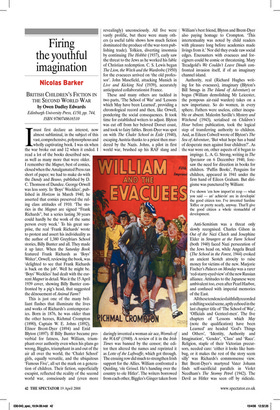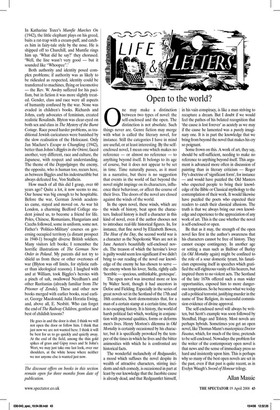Firing the youthful imagination
Nicolas Barker
BRITISH CHILDREN’S FICTION IN THE SECOND WORLD WAR by Owen Dudley Edwards Edinburgh University Press, £150, pp. 744, ISBN 9780748616510 Imust first declare an interest, now almost subliminal, in the subject of this vast, comprehensive, polymorphous and wholly captivating book. I was six when the war broke out and 12 when it ended. I read a lot of the books described new, as well as many more that were older. I remember the Magnet, best of comics, closed when the Amalgamated Press ran short of paper; we had to make do with the Dandy and Beano, published by D. C. Thomson of Dundee. George Orwell was less sorry. In ‘Boys’ Weeklies’, published in Horizon in March 1940, he asserted that comics preserved the ruling class attitudes of 1910. ‘The stories in the Magnet are signed “Frank Richards”, but a series lasting 30 years could hardly be the work of the same person every week.’ To his great surprise, the real ‘Frank Richards’ wrote to protest and assert his individuality as the author of 1,380 Greyfriars School stories, Billy Bunter and all. They made it up later. When the Saturday Book featured Frank Richards as ‘Boys’ Writer’, Orwell, reviewing the book, was ‘delighted to see that Frank Richards is back on the job’. Well he might be. ‘Boys’ Weeklies’ had dealt with the current Magnet in detail. Was it the 15 April 1939 cover, showing Billy Bunter confronted by a pig’s head, that suggested the dénouement of Animal Farm?
This is just one of the many brilliant flashes that illuminate the lives and works of Richards’s contemporaries. Born in 1876, he was older than the other heroes, Richmal Crompton (1890), Captain W. E. Johns (1892), Elinor Brent-Dyer (1894) and Enid Blyton (1897). If Billy Bunter became proverbial for fatness, Just William, triumphant over authority even when his plans go wrong, Biggles, triumphant in and out of the air all over the world, the ‘Chalet School’ girls, equally versatile, and the ubiquitous ‘Famous Five’, all set the mark on a generation of children. Their fiction, superficially escapist, reflected the reality of the second world war, consciously and (even more revealingly) unconsciously. All five were vastly prolific, but there were many others (a useful table shows how much fiction dominated the produce of the war-torn publishing trade). Tolkien, diverting insomnia by continuing The Hobbit (1937), early saw the threat to the Jews as he worked his fable of Christian redemption. C. S. Lewis began The Lion, the Witch and the Wardrobe (1950) for the evacuees arrived on ‘the old professor’. John Masefield, attacking Munich in Live and Kicking Ned (1939), accurately anticipated collaborationist France.
These and many others are tackled in two parts, ‘The School of War’ and ‘Lessons which May have been Learned’, providing a chronological record and then, like Orwell, pondering the social consequences. It took time for established writers to adjust. Blyton was cut off from her beloved Dorset coast, and took to fairy fables. Brent-Dyer was spot on with The Chalet School in Exile (1940), escaping Austria thanks to a priest then murdered by the Nazis. Johns, a pilot in first world war, brushed up his RAF slang and daringly invented a woman air ace, Worrals of the WAAF (1940). A review of it in the Irish Times was banned by the censor; the editor then altered the names and reprinted it as Lotte of the Luftwaffe, which got through. The ensuing row did much to strengthen Irish support for the Allies. William confronted a Quisling, ‘ole Grissel. He’s handing over the country to ole Hitler’. The writers borrowed from each other, Biggles’s Ginger taken from William’s best friend, Blyton and Brent-Dyer also paying homage to Crompton. ‘This intertextuality was noted by child readers with pleasure long before academics made livings from it.’ Nor did they evade raw social edges. Encounters with evacuees and foreigners could be comic or threatening. Mary Treadgold’s We Couldn’t Leave Dinah confronted invasion itself, if of an imaginary channel island.
Authority, real (Richard Hughes writing for his evacuees), imaginary (Blyton’s Bill Smugs in The Island of Adventure) or bogus (William demolishing Mr Leicester, the pompous air-raid warden) takes on a new importance. So do women, in every sphere. Fathers were useless, either incapable or absent. Malcolm Saville’s Mystery and Witchend (1943), serialised on Children’s Hour before publication, took the logical step of transferring authority to children. And, as Eileen Colwell wrote of Blyton’s The Sea of Adventure, ‘But what hope has a band of desperate men against four children?’. As the war wore on, other aspects of it began to impinge. L. A. G. Strong, writing in The Spectator on 6 December 1940, foresaw the need for direction in books for children. ‘Puffin Books’, Penguins for children, appeared in 1941 under the firm hand of Eileen Graham. But dirigisme was punctured by William:
I’ve shown ’em how import’nt resp — what you said — an’ achievin’ are in developin’ the good citizen too. I’ve invented Sardine Toffee or pretty nearly, anyway. That’ll give the good citizen a whole stomachful of development.
Anti-Semitism was a threat only slowly recognised. Charles Gilson in Out of the Nazi Clutch and Josephine Elder in Strangers at the Farm School (both 1940) faced Nazi persecution of the Jews head on, while Angela Brazil (The School in the Forest, 1944) evoked an ancient Scotch atrocity to raise money for victims of the new. Marjorie Fischer’s Palaces on Monday was a rarer ‘red-starry-eyed view’ of the new Russian alliance. Attitudes to the Japanese were ambivalent too, even after Pearl Harbor, and confused with imperial memories of the East.
All these tendencies faithfully recorded a shifting social scene, aptly echoed in the last chapter title of ‘The School of War’, ‘Officials and Genteel-men’. The five chapters of ‘Lessons which May (note the qualification) have been Learned’ are headed ‘God’s Things and Others’, ‘Identity, Authority and Imagination’, ‘Gender’, ‘Class’ and ‘Race’. Religion, staple of their Victorian precursors, needed care: ‘either it looks like humbug, or it makes the rest of the story seem silly’ was Richards’s commonsense view. But Brent-Dyer’s martyred Vater Johann finds self-sacrificial parallels in Violet Needham’s The Stormy Petrel (1942). The Devil as Hitler was seen off by ridicule. In Katharine Tozer’s Mumfie Marches On (1942), the little elephant plays on his greed, baits a rat-trap with a cream-puff, and catches him in fairy-tale style by the nose. He is shipped off to Churchill, and Mumfie rings him up. ‘What did he say?’ they chorused. ‘Well, the line wasn’t very good — but it sounded like “Whoopee”.’ Both authority and identity posed complex problems; if authority was as likely to be ridiculed as respected, identity could be transferred to machines, flying or locomotive — the Rev. W. Awdry suffered for his pacifism, but in fiction it was more slightly treated. Gender, class and race were all aspects of humanity confused by the war. None was evaded in children’s books. Richards and Johns, early advocates of feminism, created realistic Rosalinds. Blyton was clear-eyed on both sex and class in The Mystery of the Burnt Cottage. Race posed harder problems, as traditional Jewish caricatures were banished by the slow realisation of the Holocaust. Only Jan Maclure’s Escape to Chungking (1942), better than Johns’s Biggles in the Orient, faced another, very different, race and culture, the Japanese, with respect and understanding. The theme of the Doppelgänger, the enemy, the opposite, who is human too, recurs here, as between Biggles and his indestructible but always defeated foe, Von Stalhein.
How much of all this did I grasp, over 60 years ago? Quite a lot, it now seems to me. Our house was big enough to be hospitable. Before the war, German Jewish academics came, stayed and moved on. As war hit London, a charming Bedford College student joined us, to become a friend for life. Poles, Chinese, Romanians, Hungarians and Czechs followed, some in uniform, some not. Father’s ‘Politico-Military’ courses on governing occupied territory (a distant prospect in 1940-1) brought diverse British soldiers. Many visitors left books; I remember the horrific illustrations of The German New Order in Poland. My parents did not try to shield us from these or other overtones of war (Blyton was off limits, for stylistic rather than ideological reasons). I laughed with and at William, took Biggles’s heroics with a pinch of salt, swallowed Needham’s and other Ruritanias (already familiar from The Prisoner of Zenda). These and other new books merged with earlier books, read earlier, George Macdonald, Julia Horatia Ewing, and, above all, E. Nesbitt. Who can forget the end of The Railway Children, gentlest and best of childish lessons?
He goes in and the door is shut. I think we will not open the door or follow him. I think that just now we are not wanted here. I think it will be best for us to go quickly and quietly away. At the end of the field, among the thin gold spikes of grass and Gipsy roses and St John’s Wort, we may just take one last look, over our shoulders, at the white house where neither we nor anyone else is wanted just now.



















































































 Previous page
Previous page